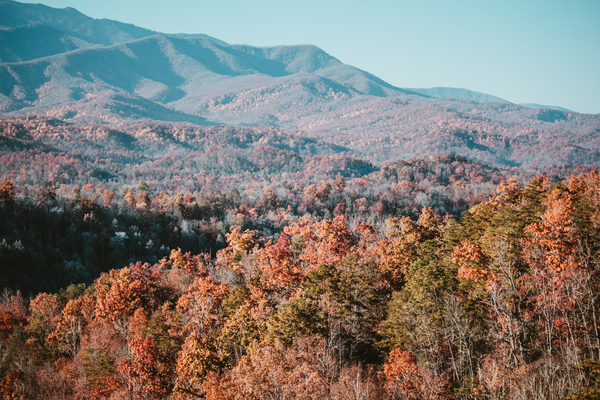North America is full of beautiful landscapes and scenic areas that play vital roles in the ecosystem while attracting visitors each year. The Appalachian Mountain range is one such landmark that stretches all the way from Northern Canada to the Southernmost United States. They are some of the oldest mountains on the planet.
Smoky Mountains Vs. Appalachian Mountains – Are They the Same?
This mountain range is broken down into smaller segments that stretch for 2,000 miles across the continent. There are several different ranges that make up the Appalachian Mountains, including the Smoky Mountains, which has led many to assume they are the same. While this assumption isn’t entirely true, it isn’t entirely wrong either.
So the Smoky Mountains are just a part of the Appalachian Mountains. Let’s look at the Appalachian Mountains and the Smoky Mountains in a bit more detail.
Appalachian Mountains

The Appalachians make up 2,000 miles of a mountain range in North America. They have been broken into three different regions; northern, central, and southern. Each region has its own systems of mountains that all connect to create the Appalachians.
The northern region reaches from Quebec to New Hampshire and Connecticut. Parts of New York, Ohio, Pennsylvania, and Maryland make up the central region of mountains. The southern range of the Appalachians can be found in Virginia, North Carolina, Tennessee, Alabama, and Mississippi.
The highest elevations can be found in Maine, New Hampshire, North Carolina, and Tennessee. The highest point overall is on Mount Mitchell. Caves, waterfalls, springs, and rivers can be found throughout the Appalachians in every region.
Climate
The climate of the Appalachian Mountains can vary drastically from one range to the next. Many of the mountains are humid, but in the Northern regions of Canada and the White Mountains, temperatures can reach subarctic levels. Low elevations in Georgia and Alabama tend to have more mild weather.
However, the White Mountains and Long Range in Newfoundland experience heavy snowfall every year. In North Carolina, Mount Mitchell has been known to receive over one hundred inches in just one year. In Mount Washington, there are strong winds and an average temperature that doesn’t reach over 71 degrees Fahrenheit.
Most regions in the Appalachians experience heavy clouds and haze.
Plants

The Appalachian mountains are nearly completely covered by forest. Many of the forests are deciduous, containing trees such as red spruce, ash, birch, walnut, and more. Altogether, the Appalachians contain 140 tree species.
Other areas of these mountain systems contain vast grasslands and meadows. Roan Mountain, found in North Carolina and Tennessee, is known for its 1,200 acres of natural gardens.
Animals

There are a number of animals that were once common across the Appalachians but have nearly disappeared. Bison, elk, and wolves once lived in several of the mountain regions, but have since disappeared. Elk have begun returning, and moose and caribou have continued living in the northern regions.
Deer, raccoons, foxes, and black bears can be found in other regions of the Appalachians. Every region boasts a large number of bird species as well.
Smoky Mountains

The Great Smoky Mountains are just one segment that makes up the greater Appalachian system. This mountain range stretches across eastern Tennessee and western North Carolina. The Smoky Mountains run right into the Blue Ridge range in North Carolina.
In some of the higher regions, you can find the Great Smoky Mountains and National Park. Mounts Chapman, Collins, Guyot, Le Conte, and Kephart can all be found in the national park. They have become a popular tourist destination that includes Gatlinburg, Tennessee, and part of the Appalachian National Scenic Trail.
The Smoky Mountains also hold the highest point in Tennessee, Clingman’s Dome. With an elevation of 6,643 feet, it’s also the highest point on the Appalachian National Scenic Trail.
Climate

The climate of the Smoky Mountains stays in the medium continental range. The average mountain temperature is 55 degrees Fahrenheit. Summer months have cooler temperatures in the low 70s, and they usually come with more rainfall. July and August are the wettest months out of the year, while October and November are the driest.
Annual rainfall can reach more than fifty inches, but severe storms are rare in the Smokies. Tornadoes have been known to happen sometimes, but they are infrequent.
Plants

The Smokies are covered in forests that contain trees such as red spruces and balsam firs. There are also more than 1,500 flowering plants found throughout the mountain ranges. Different types of these plants can be found blooming throughout the year. Some of the flowers commonly found in the Great Smoky Mountains include orchids, violets, jewelweed, and many more.
The Great Smoky Mountains National Park is home to more flowering plants than any other national park, and it even hosts a Spring Wildflower Pilgrimage every year. Blooming trees and shrubs can be found throughout the mountains as well.
Animals

Smaller mammals like raccoons, squirrels, and opossums are commonly found in the Smoky Mountains. Black bears, deer, and wildcats also call this mountain range home. In the North Carolina region, there have been efforts to reintroduce the nearly extinct red wolf.
Hundreds of bird species are also found in the Smokies, including mockingbirds, cardinals, wrens, woodpeckers, and warblers. Rivers and streams found in the mountains are homes for freshwater fish like bluegills, bass, and sunfish.
Differences and Similarities
While the Smoky Mountains are part of the Appalachians, there are other regions in the mountain system that are vastly different. In more northern sections, mountain ranges experience harsher winters and are home to a different assortment of wildlife.
However, there are other subranges that have similar landscapes and climates to the Smokies. Some of these include Blue Ridge, Cumberland Mountains, and the Unaka Mountains. Each of these ranges has plant life, animals, and weather patterns in common.
The Difference Between the Appalachian Mountains and the Smoky Mountains – The Short Answer
The short answer is that the Smoky Mountains are just one part of the Appalachians. This means they are technically the same, but there are a number of other mountain ranges that are part of the same system. The Smoky Mountains are just one subrange of a landscape that stretches through North America.
The Smokies cover around 800 square miles of the mountain range and are in one of the southernmost regions of the Appalachian system. Nearby ranges share a range of similarities, while the northern regions have some stark differences.
